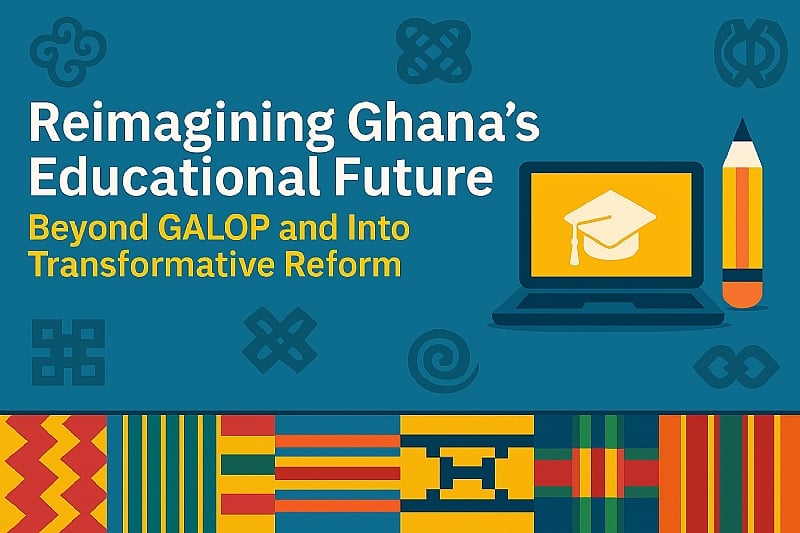Ghana’s education sector stands at a pivotal crossroads. With the recent $117 million boost to the Ghana Accountability for Learning Outcomes Project (GALOP), the nation signals a renewed commitment to foundational learning, equity, and system-wide accountability. Yet, GALOP is but one thread in a broader tapestry of reforms reshaping how Ghana educates its future citizens.
This article explores the evolving landscape of educational reform in Ghana, the anticipated impact of GALOP, and the civic pathways through which Ghanaians can champion lasting change.
I. The Broader Canvas: Educational Reforms Beyond GALOP
Ghana’s Ministry of Education, under the Education Strategic Plan (ESP 2018–2030), has launched a suite of reforms that span pre-tertiary, tertiary, and vocational education. These include:
Curriculum Overhaul: A shift to competency-based learning through the Common Core Programme (CCP), emphasizing critical thinking, creativity, and digital literacy. Teacher Education Reform: Colleges of Education have been upgraded to University Colleges, offering Bachelor of Education degrees with a focus on inclusive pedagogy and professional standards. TVET Realignment: Technical and Vocational Education and Training institutions now fall under a unified Technical and Vocational Education Service (TVES), streamlining governance and expanding access. Assessment Innovations: Introduction of the National Standard Assessment Test (NSAT) at key stages (Primary 2, 4, 6 and JHS 2) to monitor learning outcomes and guide interventions. Decentralization of Basic Education: District Assemblies now play a more active role in managing basic education, fostering local accountability and responsiveness. Digital Integration: ICT reforms aim to embed digital tools in teaching, learning, and school management, with pilot programs in coding and robotics already underway.
These reforms reflect a systemic ambition: to align Ghana’s education with global standards while rooting it in local relevance and equity.
II. GALOP’s Promise: Targeted Transformation at the Grassroots
GALOP, now fortified with additional funding, is Ghana’s flagship initiative to uplift over 10,000 underserved basic schools. Its strategic pillars include:
Improved Literacy and Numeracy: Through structured pedagogy, early grade assessments, and teacher training, GALOP aims to close foundational learning gaps. Inclusive Education: Special focus on girls, children with disabilities, and learners in rural and hard-to-reach areas. School Grants and Resources: Provision of teaching materials, digital tools, and operational support to enhance classroom delivery. Data-Driven Accountability: Schools develop and report on School Improvement Plans (SIPs), tied to performance-based funding and oversight. Community Engagement: Strengthening School Management Committees (SMCs) to foster local ownership and transparency.
By targeting the bottom 20% of schools, GALOP avoids blanket solutions and instead delivers tailored interventions where they are needed most.
III. Civic Advocacy: How Ghanaians Can Champion Reform
Education reform is not solely the domain of policymakers—it thrives when citizens become co-authors of change. Here’s how Ghanaians can engage:
Participate in Oversight Forums: Attend district education meetings, contribute to SIP reviews, and demand transparency in fund allocation. Support Teacher Development: Advocate for continuous professional development and fair deployment of trained teachers, especially in rural areas. Promote Inclusive Practices: Use cultural platforms—Adinkra symbolism, Kente storytelling, community festivals—to champion education for all, including girls and children with disabilities. Leverage Digital Tools: Encourage schools to adopt e-learning platforms, and support local initiatives that bridge the digital divide. Engage in Curriculum Dialogue: Provide feedback on the relevance of new curricula, ensuring they reflect Ghanaian values, history, and aspirations. Mobilize Youth and Elders: Intergenerational forums can amplify voices across age groups, blending wisdom with innovation in shaping education policy.
Ultimately, advocacy must be both strategic and symbolic—rooted in data, but also in the cultural soul of Ghana.
Conclusion: From Reform to Renaissance
Ghana’s educational reforms, anchored by GALOP and expanded through systemic innovation, offer a blueprint for transformation. But their success hinges on civic vigilance, cultural integration, and sustained leadership. As Ghana reimagines its classrooms, it must also reawaken its communities—ensuring that every child, from coast to savannah, learns not just to read and write, but to thrive.
Retired Senior Citizen
Teshie-Nungua
[email protected]


